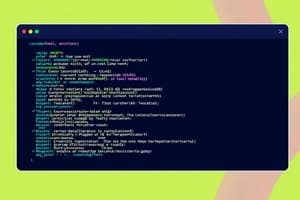Podcast
Questions and Answers
Which of the following best describes the role of HTML in web development?
Which of the following best describes the role of HTML in web development?
- To structure the content and elements of web pages. (correct)
- To add interactivity and dynamic content to web pages.
- To manage server-side operations and databases.
- To define the style and layout of web pages.
Why is HTML referred to as a 'markup language'?
Why is HTML referred to as a 'markup language'?
- Because it uses tags to define and structure elements on a webpage. (correct)
- Because it primarily handles hypertext links between web pages.
- Because it is written in a human-readable format.
- Because it uses complex algorithms to process data.
In the context of web development, how do HTML, CSS, and JavaScript typically interact?
In the context of web development, how do HTML, CSS, and JavaScript typically interact?
- HTML handles interactivity, CSS provides structure, and JavaScript adds styling.
- HTML adds styling, CSS handles interactivity, and JavaScript provides structure.
- HTML provides structure, CSS adds styling, and JavaScript adds interactivity. (correct)
- HTML, CSS, and JavaScript independently manage different aspects of web development without direct interaction.
What is the purpose of the <head> element in an HTML document?
What is the purpose of the <head> element in an HTML document?
If you want to embed a video into your HTML page, which element would you typically use?
If you want to embed a video into your HTML page, which element would you typically use?
Why is it important for web developers to understand HTML?
Why is it important for web developers to understand HTML?
Which of the following is NOT a key feature of HTML?
Which of the following is NOT a key feature of HTML?
How do search engines use HTML to rank websites?
How do search engines use HTML to rank websites?
Flashcards
What is HTML?
What is HTML?
The standard language for creating and structuring web pages.
HyperText
HyperText
Text containing links (hyperlinks) to other content.
Markup Language
Markup Language
A language that uses tags to define elements on a webpage.
HTML Tags (Elements)
HTML Tags (Elements)
Signup and view all the flashcards
Web Browser
Web Browser
Signup and view all the flashcards
Role of HTML
Role of HTML
Signup and view all the flashcards
Role of CSS
Role of CSS
Signup and view all the flashcards
Role of JavaScript
Role of JavaScript
Signup and view all the flashcards
Study Notes
- HTML (HyperText Markup Language) is the standard language for structuring web pages.
- It defines elements like headings, paragraphs, images, links, and tables.
Key Points About HTML
- Not a programming language; it's a markup language.
- HTML structures content but doesn't perform logic.
- Works with CSS for styling and JavaScript for interactivity.
- Uses opening and closing tags to define webpage parts.
- Web browsers interpret HTML files and display the content.
HyperText Explained
- HyperText contains links (hyperlinks) to other content.
Markup Language Explained
- Uses tags (e.g., , , ) to mark-up elements on a webpage.
How HTML Works
- An HTML file (with a .html extension) is opened in a web browser.
- The browser reads the code and renders the page visually.
HTML File Example
- Structure is read by the browser
- tag sets the title in the browser tab.
- tag creates a large heading.
- tag creates a paragraph.
- tag creates a clickable link
Key Features of HTML
- Simple and easy to learn basic syntax and structure.
- Platform-independent and works on all devices and browsers.
- HTML is Flexible
- Can be combined with CSS and JavaScript for styling and functionality.
- Supports Multimedia
- HTML can embed images, videos, audio, and animations
Why HTML Matters
- It is the backbone of every website
- Essential for web development as Front-end developers must master HTML.
- It is SEO-Friendly, enabling search engines to read HTML to understand and rank websites.
Perfect Web Development Trio
- HTML provides the webpage structure.
- CSS styles the page (colors, fonts, layouts).
- JavaScript adds interactivity (buttons, animations, dynamic content).
Final Thoughts
- Understanding HTML fundamentals allows users to create webpages and structure content.
- HTML enables working with CSS and JavaScript to build full websites.
Studying That Suits You
Use AI to generate personalized quizzes and flashcards to suit your learning preferences.




